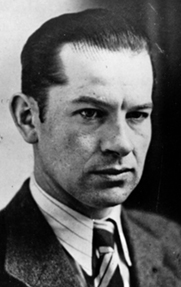Search for Names, Places and Biographies
Already layed Stumbling Stones
Suche
Gustav Bruno Endrejat * 1908
Valentinskamp 42 (Hamburg-Mitte, Neustadt)
HIER WOHNTE
GUSTAV BRUNO
ENDREJAT
JG. 1908
IM WIDERSTAND
VERHAFTET 6.1.1944
KZ NEUENGAMME
GEHENKT 23.4.1945
Gustav Bruno Endrejat, born 5/19/1908 in Friedrichswalde, Eastern Prussia, arrested 1944, murdered at Neuengamme concentration camp on 4/23/1945
Valentinskamp 42
Bruno Endrejat was born as the son of the estate treasurer Heinrich Endrejat (died 9/3/1927) and his wife Maria Bertha, née Lenuweit, in Friedrichswalde, county Tilsit-Ragnit in Eastern Prussia. He came to Hamburg around 1929. On May 26, 1934, he married Grete Erna Liedtke, a dressmaker, born July 15, 1910 in Gross Engelau, Eastern Prussia.
After the Nazis came to power in 1933, opponents of the regime continued their political activities underground in various resistance groups. Bruno Endrejat was such an opponent, one of the "group or five” with William Dabelstein (cf. there), Heinrich "Hein”, a heating installer, the chemigrapher Kurt Schill, his wife Hilde and others. Their activities focused on the residential areas around Grossneumarkt. They concealed wanted resistance fighters, collected money and helped out with food ration cards. And they printed handbills on a small mimeograph, e.g. before the imminent execution of the popular Communist functionary Etkar André (cf. there. On November 4, 1936, Etkar André, sentenced to death for "preparation of high treason”, was guillotined at the Hamburg remand jail.) Before the banning of the communist party KPD in 1933, the party’s Hamburg headquarters, the headquarters of the coastal section "Bezirksleitung Wasserkante” and the editorial offices of the party newspaper Hamburger Volkszeitung were located at the building where Bruno Endrejat lived. Since 1942, Endrejat worked at the tool dispensary of the August H. Lehnhoff company in Hamburg-Eimsbüttel. Previously, he had worked at Ottensener Eisenwerke, where he had met the ship’s carpenter Walter Bohne (born 1/9/1903). In late July 1943, he temporarily gave the resistance fighter shelter – a dangerous undertaking, as by then a center of the Hitlerjugend, the Nazi youth organization, was located on the ground floor of the building where he lived. Bohne, a member of the Bästlein-Jacob-Abshagen resistance group, had not returned to the remand jail from leave he had been granted after the jail had been severely damaged by the air raids of July 1943.
When Walter Bohne was shot by Gestapo agent Henry Helms (born 10/1/1902) when resisting arrest on January 5, 1944 at Klosterstern place, he was carrying a milk ration card that led to Kurt Schill, who had supplied Bohne with ration cards. The following day, Schill and also Bruno Endrejat and his wife were arrested for "preparation of high treason”. After the war, a former fellow prisoner reported that Endrejat had been in solitary confinement and the Gestapo had offered to release if he would work as an informer for them in the harbor. Bruno Endrejat refused and stayed in jail.
Kurt Schill, the Communist Hans Hornberger (cf. Stolpersteine in Hamburg-Eimsbüttel) and Gustav Bruhn and his wife Elisabeth (born 12/26/1893 – cf. Stolpersteine in Hamburg-Eimsbüttel) were taken to Neuengamme concentration camp on February 14, 1944 and hanged in the execution bunker by order of Heinrich Himmler, head of the SS, without previous trial.
When the Fuhlsbüttel police prison was evacuated in April 1945 before advancing Allied forces occupied Hamburg, lists of three groups of prisoners were compiled. The first group was released, the second group taken to the labor camp in Kiel-Hassee. As this camp was insufficiently secure, the third group of prisoners, the "serious cases”, mainly political prisoners from various resistance groups, Soviet POWs and French slave laborers, was taken to the prison of Neuengamme concentration camp on April 20, 1945. These prisoners were on the so-called liquidation list and should by no means fall into the hands of the Allies. Bruno Endrejat and Heinrich Matz were among the 71 men and women who, by order of the commanding SS and police officer Georg Henning Graf von Bassewitz-Behr (born 3/21/1900 in Lützow, Mecklenburg) were murdered without trial in the so-called arrest bunker during the nights from April 22 to 23 and 23 to 24, 1945. The women (cf. Hanne Mertens) were the first to be killed – they were hanged from the bunker’s ceiling beams side by side in two groups. Some of the men got an idea what they were in for and barricaded themselves in their cells. The SS guards then threw hand grenades through the bunker windows. Some of the men were killed instantly, the survivors subsequently hanged or shot to death (cf. glossary for details).
After 16 months of imprisonment, Grete Endrejat was among the prisoners taken to the labor camp Kiel-Hassee on April 16, 1945. There, she caught a serious ear infection, which caused her to completely lose her hearing on the right side. But she survived. Grete Endrejat died on August 5, 1991 in Hamburg.
After the war, Georg Henning Graf von Bassewitz-Behr, the man responsible for the murder of the 71 prisoners, was among those accused of war crimes in the Hamburg Curiohaus trial in August 1947. He was acquitted and then turned over to the Soviet authorities. He died on January 31, 1949 at a prison camp in eastern Siberia.
A Stumbling Stone at Bartelsstrasse 53 commemorates Kurt Schill (cf. Stolpersteine in Hamburg-Altona).
A Stumbling Stone for Walter Bohne was laid at Klosterstern 5 (cf. Stolpersteine in Hamburg-Eimsbüttel).
Translated by Peter Hubschmid
Kindly supported by the Hermann Reemtsma Stiftung, Hamburg.
Stand: May 2020
© Susanne Rosendahl
Quellen: StaH 351-11 AfW Abl. 2008/1, 05071910 Endrejat, Grete; StaH 332-5 Standesämter 14260 u 471/1934; Auskünfte von Herbert Diercks, Archiv der KZ-Gedenkstätte Neuengamme Bestand VVN; Diercks: Gedenkbuch Kola-Fu; Diercks: Dokumentation, S. 46–48; Buck: Widerstand, S. 170–172; Meyer: Nacht, S. 103–109; Puls: Bästlein-Jacob-Abshagen-Gruppe; Sparr: Stolpersteine, S. 163; Dabelstein: Engelsaal, S. 28; Jacobs: Himmlers Mann, S. 123; www.akens.org (Zugriff 16.4.2016); www.ancestry.de. (Sterberegistereintrag von Heinrich Endrejat am 3.9.1927, Althof-Insterburg, Zugriff 23.9.2017).


